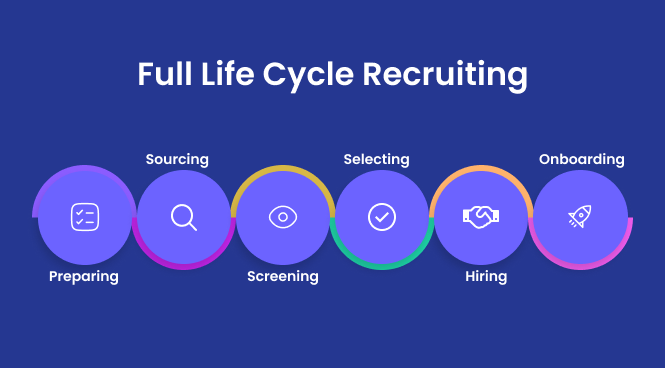Table of Contents
ToggleWhat is Full Cycle Recruiting?
Full cycle recruiting, also known as full cycle recruitment, is a comprehensive hiring process in which a recruiter or hiring team manages every stage of recruitment from start to finish. This process typically includes six key phases: preparing, sourcing, screening, selecting, hiring, and onboarding. Unlike traditional recruitment models, where different teams or individuals handle separate stages of the hiring process, full cycle recruiting consolidates these responsibilities under a single recruiter or a dedicated hiring team. This approach ensures a more streamlined and consistent recruitment cycle, improving both efficiency and candidate experience.
One of the main advantages of full cycle recruiting is its ability to enhance communication and accountability throughout the hiring process. Since one person or team oversees all aspects of recruitment, there is less chance of miscommunication between departments, reducing delays and ensuring a more seamless candidate journey. Additionally, recruiters who manage the full cycle recruiting process develop a deeper understanding of the company’s hiring needs, employer brand, and talent expectations, allowing them to make better hiring decisions and improve long-term retention.
Why Is Full Cycle Recruiting So Important?
The importance of full cycle recruiting lies in its ability to optimize the hiring process, making it more efficient and effective for organizations. By consolidating all recruitment responsibilities into one role or team, companies can significantly reduce time-to-hire, ensuring that top candidates are not lost to competitors. A well-structured full cycle recruiting process also enhances the candidate experience by providing consistent communication and a more personalized approach. Studies show that a positive candidate experience improves employer branding and increases the likelihood of candidates accepting job offers.
From a business perspective, full cycle recruiting contributes to better workforce planning and talent acquisition strategies. Since recruiters involved in the full hiring cycle gain insights into job market trends, candidate behavior, and hiring challenges, they can refine their approach over time to attract higher-quality candidates. Additionally, organizations benefit from cost savings, as a more efficient recruitment cycle reduces the need for multiple recruitment agencies or excessive resources. Overall, implementing a full cycle recruiting approach helps businesses build strong, high-performing teams while maintaining a competitive edge in the job market.
The Steps of Full Cycle Recruiting Process
A successful full cycle recruiting process consists of several key steps, each playing a vital role in ensuring a smooth and effective hiring experience. Unlike fragmented hiring models where multiple individuals handle different parts of recruitment, full cycle recruiting provides a structured approach that improves efficiency and accountability. The process includes six main stages: preparing, sourcing, screening, selecting, hiring, and onboarding. Each step contributes to a seamless recruitment cycle, ensuring that companies attract, evaluate, and retain the best talent.
By following a well-defined full cycle recruitment workflow, businesses can reduce hiring delays, enhance candidate experience, and make more informed hiring decisions. Additionally, a structured recruitment cycle helps organizations align their hiring strategies with business goals, improving overall workforce planning. Below is a breakdown of each step and its significance in achieving a successful full-cycle recruiting process.
Preparing
The preparation stage is the foundation of any effective recruitment cycle. At this stage, hiring managers and recruiters work together to define the role, establish hiring requirements, and outline key responsibilities for the open position. A well-crafted job description is crucial, as it sets clear expectations for potential candidates and ensures that recruiters attract the right talent. Organizations also determine the budget, salary range, and benefits package during this phase to remain competitive in the job market.
In addition to defining the role, recruiters must also assess workforce planning needs and identify potential hiring challenges. Market research and competitor analysis can help companies understand industry trends and adjust their hiring strategies accordingly. By thoroughly preparing before launching the full cycle recruiting process, organizations can streamline hiring efforts and improve the chances of securing top talent.
Sourcing
Sourcing is the proactive process of identifying and attracting potential candidates. This step in the recruitment cycle involves using various channels, such as job boards, social media, professional networks, and employee referrals, to build a strong talent pool. A key advantage of full cycle recruiting is that recruiters take ownership of sourcing strategies, ensuring they target the right audience with compelling job postings and outreach campaigns.
Modern recruitment cycles also incorporate AI-driven sourcing tools and applicant tracking systems (ATS) to streamline the process. These technologies help recruiters filter candidates based on skills, experience, and qualifications, saving time and improving efficiency. A strong sourcing strategy ensures that recruiters connect with both active and passive candidates, increasing the chances of finding high-quality talent.
Screening
Once potential candidates have been identified, the next step in the full cycle recruiting process is screening. This phase involves evaluating resumes, cover letters, and application responses to shortlist the most suitable candidates. Recruiters assess qualifications, work experience, and cultural fit to ensure alignment with the organization’s needs. Automated resume screening tools and AI-driven assessments can help speed up this process, allowing recruiters to focus on the most promising applicants.
Beyond reviewing resumes, many companies also conduct initial phone or video screenings to further assess candidates before moving them to the next stage. These conversations help recruiters evaluate communication skills, career goals, and overall enthusiasm for the role. A well-executed screening process not only narrows down the talent pool but also enhances candidate experience by keeping communication clear and transparent.

Selecting
The selection phase is one of the most critical parts of the recruitment cycle, as it involves making final decisions about which candidates will advance in the hiring process. At this stage, recruiters and hiring managers conduct in-depth interviews, skill assessments, and reference checks to determine the best fit for the role. Depending on the position, this step may include technical evaluations, behavioral assessments, and panel interviews to gain a comprehensive understanding of the candidate’s capabilities.
A structured selection process ensures that hiring decisions are based on merit, reducing bias and improving the overall effectiveness of full cycle recruiting. Additionally, collaboration between recruiters and hiring managers is crucial during this phase to ensure alignment with business needs and long-term company goals. By thoroughly evaluating each candidate, organizations can make informed hiring decisions that contribute to long-term employee success and retention.
Hiring
The hiring stage marks the transition from candidate selection to making a formal job offer. In a well-executed full cycle recruiting process, recruiters negotiate salary packages, benefits, and contract terms with the chosen candidate. This phase requires clear communication to ensure both parties are aligned on expectations before finalizing the employment agreement. A smooth hiring process enhances employer branding and improves candidate experience, increasing the likelihood of offer acceptance.
Additionally, recruiters should be prepared for counteroffers and negotiations, as top candidates may have multiple job opportunities. A well-structured hiring process should also include a contingency plan in case the selected candidate declines the offer. Ensuring a seamless hiring phase not only secures the best talent but also strengthens the overall recruitment cycle, making future hires more efficient.
Onboarding
Onboarding is the final and often overlooked stage of full cycle recruiting, yet it plays a crucial role in employee retention and long-term success. Effective onboarding involves integrating new hires into the company culture, providing them with the necessary resources, and setting clear expectations for their roles. Studies have shown that a structured onboarding process significantly improves employee engagement, productivity, and retention rates.
A well-designed onboarding program includes orientation sessions, mentorship opportunities, and performance milestones to help new employees adapt to their roles. Additionally, recruiters who oversee the full cycle recruitment process play a key role in ensuring a smooth transition for new hires by maintaining communication and addressing any concerns. Investing in a strong onboarding strategy completes the recruitment cycle and sets employees up for long-term success within the organization.
Challenges that Come with Full Cycle Recruitment
While full cycle recruitment offers numerous benefits, it also presents challenges that organizations must address to ensure its success. Managing the entire recruitment cycle—from job requisition to onboarding—requires a strategic approach, strong coordination, and skilled recruiters who can balance multiple responsibilities. Companies that implement full cycle recruiting must be aware of potential difficulties that could arise, especially when scaling their hiring processes.
Some of the most common challenges include determining whether full cycle recruiting is the right approach for a business, finding skilled recruiters who can manage the entire process effectively, and dealing with the complexities of time management. Overcoming these obstacles requires careful planning and the use of technology to streamline recruitment cycles.
Not Suitable for All Sizes of Business
Full cycle recruiting may not be the best fit for every company, especially those with high-volume hiring needs or complex organizational structures. Large enterprises with frequent hiring demands often rely on specialized recruitment teams where different professionals handle separate stages of the hiring process. For example, sourcing specialists, recruiters, and hiring managers may each take responsibility for a different phase of the recruitment cycle. In such cases, using full cycle recruitment for every role may lead to inefficiencies or overburden recruiters with excessive responsibilities.
On the other hand, smaller businesses and startups may benefit from full cycle recruiting, as it allows them to manage hiring efficiently without relying on large HR teams. However, even in smaller organizations, a single recruiter handling every stage can be overwhelming, especially if the company is experiencing rapid growth. Businesses must assess their hiring needs, company size, and internal capabilities before deciding whether a full cycle recruitment process is the best approach.
Finding a Skilled Full Cycle Recruiter Can Be Difficult
One of the biggest challenges in implementing a full cycle recruiting process is finding recruiters who possess the necessary skills to handle every aspect of hiring. A successful full cycle recruiter must be proficient in sourcing, screening, interviewing, negotiating offers, and onboarding new hires. Additionally, they must have strong interpersonal skills to engage with candidates, hiring managers, and executives while maintaining a strategic mindset to align hiring decisions with business goals.
However, many recruiters specialize in only certain stages of the recruitment cycle, making it difficult to find professionals who can manage the entire process effectively. Companies looking to implement full cycle recruitment must invest in training and development programs to upskill their recruiters or consider hybrid hiring models where recruiters handle most stages but receive support from specialists when needed. Without a skilled full cycle recruiter, businesses risk inefficiencies in their hiring process, leading to longer time-to-hire and lower candidate satisfaction.
Time Management Can Become Very Difficult
Time management is a significant challenge in full cycle recruiting, as recruiters must juggle multiple responsibilities across different hiring stages. Handling sourcing, screening, interviewing, and onboarding simultaneously requires excellent organizational skills and the ability to prioritize tasks effectively. Without proper time management strategies, recruiters may become overwhelmed, leading to delays in the hiring process and a poor candidate experience.

To overcome this challenge, companies must equip recruiters with the right tools and technologies, such as applicant tracking systems (ATS), hiring software for small business, and automation software. These tools help streamline repetitive tasks like resume screening and interview scheduling, allowing recruiters to focus on more strategic aspects of the hiring process. Additionally, businesses should set realistic hiring timelines and allocate resources efficiently to prevent burnout among full cycle recruiters. By optimizing time management, companies can ensure a smooth recruitment cycle and maintain high-quality hiring outcomes.
The Best Practices For Full Cycle Recruitment Process
To run an effective full cycle recruiting process, organizations need to adopt a combination of strategic approaches, best practices, and technology. Since full cycle recruitment spans the entire hiring process—from preparing job descriptions to onboarding new employees—careful planning and consistent execution are necessary to avoid pitfalls. By following a set of best practices, businesses can streamline their recruitment cycles, improve candidate experiences, and enhance overall hiring efficiency.
The following best practices are designed to optimize the recruitment process, enabling companies to attract the right talent, improve hiring outcomes, and reduce the time-to-hire. By incorporating technology, focusing on employee needs, and being proactive in talent acquisition, businesses can build a strong, efficient, and sustainable recruitment process that works well for both recruiters and candidates.
Use Tech To Your Advantage
Technology plays a crucial role in optimizing the full cycle recruiting process. From sourcing and screening candidates to tracking applicants and managing interviews, recruitment software and automation tools can help streamline tasks and improve efficiency. Applicant Tracking Systems (ATS), AI-driven sourcing tools, and video interviewing platforms are some of the most widely used technologies that enable recruiters to automate repetitive tasks, reduce manual effort, and focus on strategic activities such as relationship-building with candidates.
Moreover, integrating data analytics into the recruitment cycle can provide valuable insights into hiring trends, candidate behavior, and recruitment performance. This data-driven approach allows recruiters to make informed decisions, fine-tune their strategies, and predict future hiring needs. By leveraging technology, organizations can not only speed up the hiring process but also ensure a more efficient, transparent, and effective recruitment cycle, improving the overall quality of hires.
Keep Employee Needs at the Forefront
In full cycle recruiting, it’s essential to keep the needs of both the business and potential employees at the forefront of the hiring process. A key aspect of recruitment cycles is understanding what candidates are looking for in a job—such as career growth opportunities, work-life balance, and organizational culture—while simultaneously ensuring that the company’s business objectives are met. This requires recruiters to align job descriptions, candidate screening, and interviewing practices with the expectations of the workforce, creating a mutually beneficial recruitment process.
One effective way to keep employee needs at the forefront is by actively gathering feedback from current employees regarding their experience with the recruitment process and the work environment. Understanding employee satisfaction and needs helps create a recruitment cycle that appeals to top talent, making the company more attractive to prospective candidates. Additionally, considering diversity and inclusion as part of the recruitment strategy further enhances the process by ensuring a broader range of candidates are considered and welcomed. Keeping the focus on employee needs ensures that the company attracts not only highly skilled candidates but also those who will be a good cultural fit.
Don’t Start Hiring Only When There Is an Opening
A proactive approach to full cycle recruiting means not waiting until there is an immediate vacancy to begin hiring. Rather than reacting to job openings as they arise, companies should build and maintain a strong talent pipeline throughout the year. This involves continuously sourcing candidates, nurturing relationships with passive candidates, and engaging with high-potential individuals even when there are no open positions. By doing so, organizations can reduce the time-to-hire and ensure they are ready to fill roles quickly when they do arise.
Building a talent pipeline can involve attending networking events, engaging with professional groups, and leveraging social media platforms like LinkedIn to attract potential candidates. Regularly reviewing and updating this talent pool allows recruiters to identify individuals who align with the company’s needs, even before positions are posted. This forward-thinking approach to recruitment cycles helps organizations avoid delays in hiring, ensuring they don’t miss out on top talent when a new opening becomes available. By not waiting until there’s an immediate need, companies can better anticipate their workforce requirements and keep hiring efforts steady and efficient.
Conclusion
Full cycle recruiting offers significant advantages for organizations aiming to streamline their hiring processes and create a more efficient, cohesive recruitment strategy. By managing the entire recruitment process—from preparing job descriptions to onboarding new employees—companies can ensure a consistent, high-quality candidate experience while maintaining better control over the hiring timeline. However, to truly optimize the full cycle recruitment process, businesses must embrace best practices such as leveraging technology, keeping employee needs in focus, and taking a proactive approach to talent acquisition.
While there are challenges associated with full cycle recruiting, such as managing time effectively, finding skilled recruiters, and determining its suitability for different business sizes, these obstacles can be overcome with careful planning and the right tools. As organizations continue to scale, adopting a full cycle recruiting process—backed by modern technology and strategic planning—can significantly improve the quality of hires, reduce time-to-hire, and provide a competitive edge in the talent marketplace. By understanding and applying the insights provided, companies can transform their recruitment cycles, ultimately building stronger, more dynamic teams capable of driving business success.









